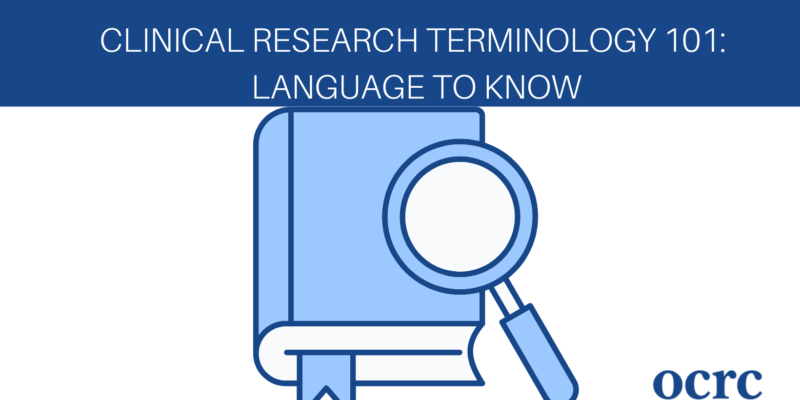
Any medications or procedures used today, as well as new data and discoveries, had to go through extensive clinical research and trials to ensure their safety and efficacy. Clinical research is a complex procedure, but understanding how it works should not be. Knowing the right clinical research terminology can go a long way toward helping you understand how the process works.
You may come across both of these terms, so it is crucial that you know the difference. Clinical research is patient-oriented research conducted on human subjects or a sample that comes from humans (i.e., organs or tissue samples), in which the researcher interacts with the subjects directly.
The most common types of patient-oriented research include:
Clinical research also refers to behavioral and epidemiological studies as well as healthcare services research.
A clinical trial fits under the umbrella of clinical research. It is an experiment designed to answer specific questions about treatments, illnesses, medications, and more.
The volunteers chosen for the clinical research project are either healthy people who don’t have ties to the conditions related to the study or patient volunteers who are affected by the health issues being researched.
Clinical research goes through many phases.
Phase I involves clinical trials with a small group of people, generally between 20 and 80, to evaluate everything from safe dosage ranges to the type of side effects that can be expected. This phase can include patient volunteers as well as healthy participants.
Phase II takes place with a larger group of volunteers, usually a few hundred, to continue establishing safety and efficacy. This phase involves people who have the condition being studied and can help determine risks and short-term side effects.
Phase III involves thousands of participants, comparing the intervention to other similar procedures while also keeping an eye on adverse effects. This is the phase where the most information is gathered to present for approval.
Phase IV takes place after the intervention has been marketed. It can help check effectiveness in the general population and provide information on side effects.
Clinical research terminology will include whether the trial was single-blind or double-blind.
Single-blind means that the researchers know whether a participant is receiving a placebo or the active treatment — while the participant does not know. A double-blind study is one in which neither the researcher nor the participant knows until after the trial is over.
A serious adverse event is any adverse health issue that occurs in a participant during the clinical trial and:
Serious adverse events are investigated and determined to be related or unrelated to the treatment being studied.
An intervention can be a procedure or a treatment like a drug, supplement, vaccine, behavior modification, or device modification.
Inclusion and exclusion criteria refer to the screening requirements that a volunteer must meet to participate in the trial. Factors can be age, sex, medical history, and much more.
Good clinical practice is the standard for the performance, conduct, design, auditing, recording, reporting, and analysis of clinical trials. It helps ensure that the data provided is accurate and that all of the participants’ rights are respected.
Quality assurance is a clinical research term that means the systematic approach that makes certain data is gathered and recorded following good clinical practices and standard protocol. It refers to operational steps taken to ensure that the trial follows all quality-related activities. These operational steps can involve checking completed forms.
Before a volunteer can participate in a clinical trial, they must be given all of the information on the trial, the schedules, expected treatments, and potential adverse reactions in writing. The volunteer must sign their consent.
Researchers help eliminate bias by turning to randomization. This is the process of assigning treatments in a random fashion.
These are the rules that would prompt the stopping of the trial. The reasons a halt to the trial can occur involve everything from safety concerns to futility.
A placebo is an inactive liquid, pill, powder, or other intervention that provides no treatment value. During clinical trials, placebos provide a comparison against which to measure the effectiveness of treatment.
A placebo-controlled study is a trial in which a placebo is given to a group of participants while an active intervention is given to the other group.
This type of trial is one in which all participants and investigators know about the intervention being tested.
The manual of procedures provides the protocol for the trial. It helps to keep protocol implementation and data collection consistent throughout the length of the trial.
Clinical research terminology can seem overwhelming, but having the basics down can help you understand the research and results.
At Orlando Clinical Research Center, we welcome participants who are interested in the research studies that are currently ongoing. Learn more by contacting us today.
